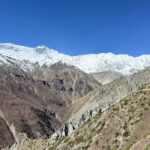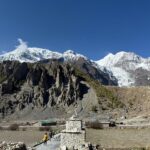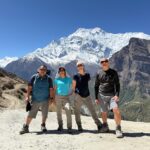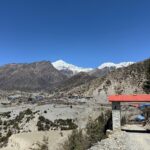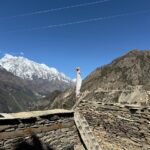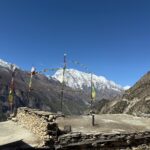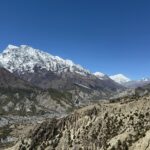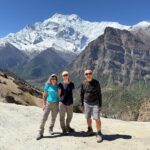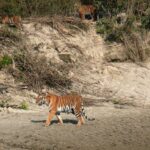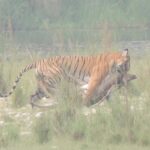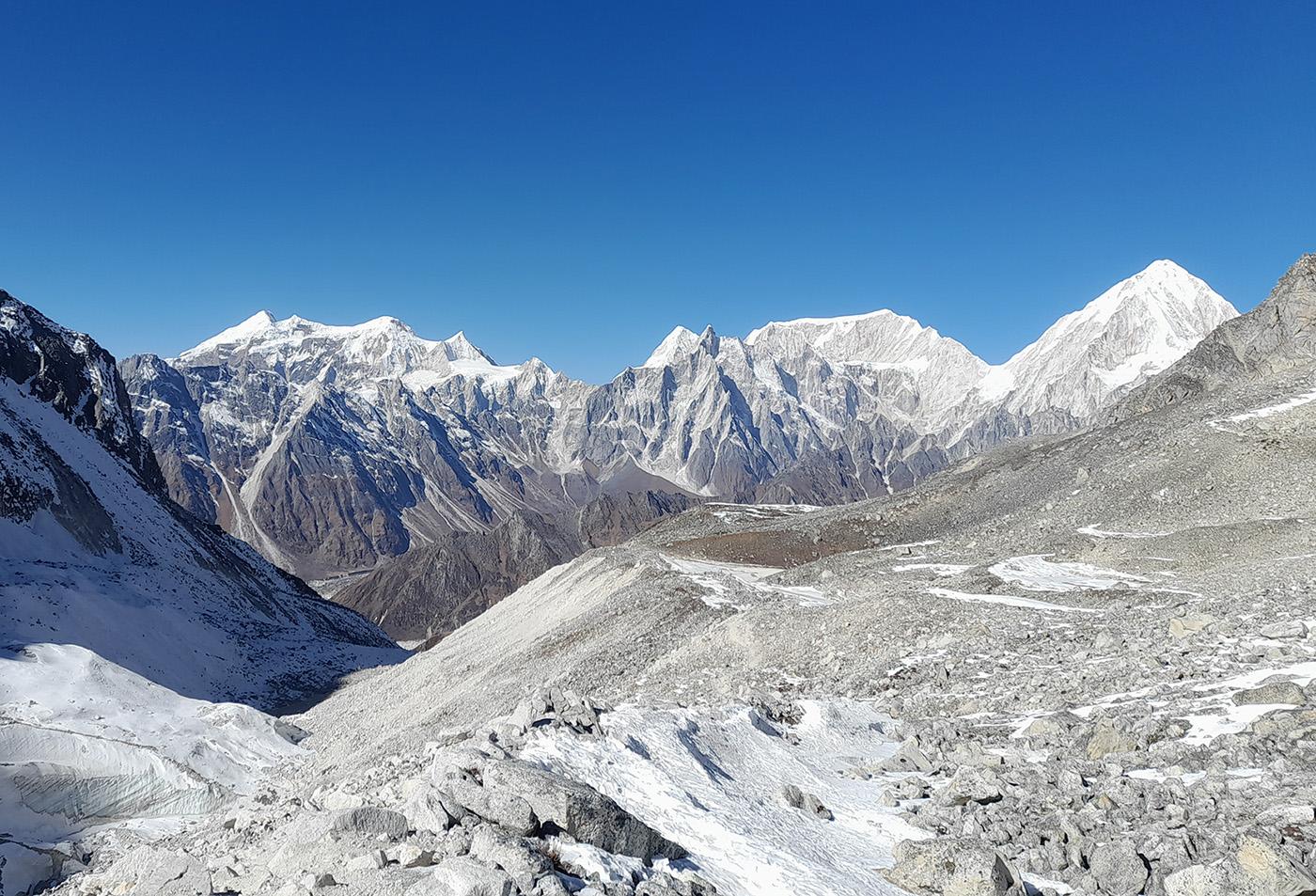
Which Trek is more Challenging: Everest Base Camp Trek vs Manaslu Trek?
The Manaslu Trek is regarded as more challenging than the Everest Base Camp (EBC) Trek because of its remoteness, fewer maintained paths, and higher general difficulty. With less facilities along the way, the Manaslu Circuit negotiates difficult terrain, steep climbs, and downfalls. Trekkers must traverse the physically taxing high-altitude pass usually covered in snow, the Larkya La Pass (5,106 meters), which adds to the challenge of the walk. For experienced trekkers looking for adventure, the limited infrastructure and restricted-area permits also demand more planning and self-sufficiency.
On the other hand, the Everest Base Camp Trek provides superior infrastructure that facilitates navigation and acclimatization including teahouses, lodges, and defined paths. Still, the climb presents major altitude difficulties; at EBC, the path rises to 5,364 meters and passes Kala Patthar for expansive views. Although this famous path is normally less secluded, the great footfall on it means that trekkers may face crowd-related difficulties.
While EBC provides famous scenery and a well-supported trek, Manaslu trekking suits those looking for seclusion and tough adventure, therefore both climbs have rewarding unique approaches.
Introduction: Everest and Manaslu
Mount Everest, the tallest peak in the world, rises to 8,848 meters (29,029 feet) above sea level. It straddles the border between Nepal and Tibet (China) in northeastern Nepal and is part of the Mahalangur mountain range in the Khumbu region.
The Mahalangur Himal range is home to four of the six highest peaks on the planet: Everest, Lhotse, Makalu, and Cho Oyu.
In contrast, Mount Manaslu, standing at 8,163 meters (26,781 feet), ranks as the eighth-highest mountain globally. It is situated in the Mansiri Himal range of the Himalayas in north-central Nepal.
This mountain lies in the Gorkha district and is a favored spot for trekking and mountaineering. The Mansiri Himal range is divided from the Annapurnas by the Marsyangdi River.
Altitude Challenge: Everest Base Camp Trek vs Manaslu Trek
The altitude of the Himalayas presents one of their difficult aspects. About 5,364 meters (17,598 feet) above sea level, the Everest Base Camp journey brings you Right at the base camp. For those who are daring higher, it can reach 5,643 meters (18,514 feet). That is at Kala Patthar. Conversely, the Manaslu Circuit walk brings one to the Larkya La Pass. It sits at 5,160 meters (16,930 feet).
Everest seems to have the edge in terms of height at first look Still, one should take the length of the walk and acclimatization into great thought. The trip to the Everest Base Camp is not long in comparison. From Lukla, most walkers travel the round trip in 12 to 14 days. Conversely, Manaslu runs roughly 15 to 18 days.
The Manaslu journey’s length lets one better adjust. It lowers the acute mountain sickness (AMS) risk. Manaslu’s slow climb and the time spent at several altitudes help to reduce its intimidating nature. It offers less altitude challenge than Everest.
Duration & Length Challenge: Everest Base Camp Trek vs Manaslu Trek
The Everest Base Camp Trek spans 130 kilometers. While this distance may seem daunting, a well-organized trek allows you to hike for just 9 out of 12 days. You’ll cover approximately 15 kilometers each day, primarily on rugged and occasionally snowy trails. The uphill portions can feel more strenuous than the downhill ones. If you prefer, you can hire a local porter to carry your gear, letting you focus on the trail and truly enjoy the hiking experience.
The Manaslu Circuit Trek begins in Soti Khola or Machhi Khola, which is about an 8 to 9-hour bus ride from Kathmandu. This trek covers 177 kilometers and typically takes 10 to 12 days, depending on your daily walking pace. It presents a greater challenge for beginners. One of the toughest parts is the Budhi Gandaki Gorge, featuring steep ascents and descents. Along the way, you’ll also cross numerous suspension bridges, adding to the excitement of the journey.
Difficulty and Safety
The Manaslu Circuit Trek is known for being a challenging journey among the popular treks in Nepal’s Himalayan region. Covering a distance of 177 km on foot, trekkers must navigate rough terrains along with steep ascents and descents. On average, you will walk for 6-7 hours each day on this less-developed trail, which takes you over wooden bridges and through pristine areas of the country, making it a demanding trek.
Despite its challenges, the trek is not deemed dangerous as long as you are physically and mentally prepared. You will encounter issues like altitude sickness when crossing the Larke Pass, which is over 5,000 m (16,404 ft) high. npredictable weather, steep climbs and descents, and potential snowfall can also pose challenges. Therefore, being well-prepared in terms of physical fitness and gear is crucial.
It is advisable to have a physical checkup before embarking on the trek due to the lack of immediate medical facilities, although helicopter evacuation is an option in emergencies. Be sure to pack medications for common ailments, a broad-spectrum antibiotic, and any specific medications you may need.
In comparison, the Everest Base Camp Trek is more accessible and suitable for trekkers of all ages. However, it does involve reaching a higher altitude, which brings its own set of challenges. As you make your way through the Khumbu region to the base camp, you will need to summit Kalapathhar at 5,555 m (18,225 ft), which increases the risk of altitude sickness. Even the starting point of this trek can lead to mild altitude sickness for some trekkers.
With a daily elevation gain of 600-800 meters, both physical and mental preparation are essential to handle the challenges of the Everest Base Camp trek. You can expect to walk for an average of 5-6 hours each day, making the trek moderately strenuous and somewhat challenging. Regarding your safety during the EBC trek, you may encounter health issues such as food poisoning or altitude sickness. Other potential concerns include limited oxygen, overexertion, dehydration, sunburn, and various environmental hazards.
Thus, the safety measures applicable to the Manaslu Circuit also apply here, along with the option of helicopter evacuation in case of emergencies.
Landscapes and Scenery
The Manaslu Circuit Trek, which spans 177 kilometers and includes at least six climatic zones, offers trekkers a stunning array of landscapes. Beginning with lush forests along the Budi Gandaki River, the scenery dramatically changes as you ascend to the Larke Pass.
The forests are vibrant with various shades of rhododendrons and alpine flowers, showcasing the region’s rich flora and fauna. After passing Dharmasala, you’ll encounter a stark, desert-like terrain. This beautiful trek features breathtaking views of Mt. Manaslu, Annapurna II, Himchuli, Ganesh Himal, Shringi Himal, and other magnificent snow-capped peaks.
The Everest Base Camp trek offers landscapes and views that rival those of the Manaslu Circuit. As you navigate through some of the world’s most iconic scenery, this trek provides a visual feast for trekkers, creating memories that last a lifetime.
Starting with the lush greenery of Lukla, the trail follows the Dudh Koshi River, weaving through pine and rhododendron forests until you reach Namche Bazar, where the breathtaking first glimpse of Everest appears. As you continue along the imposing face of Everest, you traverse the Khumbu region, rich in culture, crossing alpine meadows and high-altitude deserts, all while being surrounded by towering peaks. Upon arriving at the base of the mountain that reaches for the sky—Sagarmatha at EBC—you’ll be awestruck by the glacial splendor of the Khumbu Glacier and the Khumbu Icefall.
The trek culminates at Kalapathhar, where you’ll be treated to jaw-dropping views of Lhotse, Nuptse, Pumori, and Mount Everest, ensuring this trek is etched in your memory forever. In addition to these giants, you’ll also enjoy stunning vistas of Ama Dablam, Cho Oyu, Makalu, Thamserku, and other majestic peaks throughout your journey.
Weather Challenge: Everest Base Camp Trek vs Manaslu Trek
The difficulty of the treks is much determined by the weather. The erratic nature of the Himalayan weather is well known. It changes quickly, even during the finest times for trekking.
For Manaslu as well as Everest, the main trekking seasons are spring (March to May) and autumn (September to November).
Usually the temperature is constant throughout these periods, and the sky are clear. Trekkers still should be ready for rain or snowfall, though. Especially at higher altitudes.
Particularly at night, both trips can encounter frigid conditions. Everest Base Camp is higher on altitude. It so may be cooler than the Manaslu Circuit. On each trail, trekkers have to pack appropriate gear and clothes.
On both journeys, weather might provide difficulties. Manaslu’s lower height could give it a minor edge. It is noteworthy, nonetheless, because weather changes year to year. Trekkers should so always be ready for unanticipated developments.
Trekking permits for Everest Base Camp Trek and Manaslu Trek
EBC Trek and Manaslu Trekkers have to obey rules and acquire the required permits. Permits are needed for the Manaslu and Everest treks. The expenses and procedures vary only.
Additionally for the Manaslu Circuit is a specific restricted area permit needed. Compared to the Everest permits, these ones cost more. Trekkers should also be in at least two person group. They ought also to have a registered guide. It can increase the whole running costs.
Trekking from the Everest Base Camp also calls for licenses. Still, they are less expensive and more easily available. On the Everest path, single hikers are let in. Still, it is advisable to travel in a group or with a guide. Safety considerations guide it.
The Manaslu walk can be a little more difficult with its bureaucratic elements. It relates to costs and logistics. Some walkers, nevertheless, value the limited access. It keeps a less packed and calmer trail.
Cultural Experience: Everest Base Camp Trek against Manaslu Trek
The Manaslu and Everest hikes are a very remarkable experience. One can fully appreciate the rich Himalayan people’s culture. Still, the cultural encounter will differ.
The path from the Everest Base Camp winds past Sherpa communities right in middle ground. There are Sherpa villages in Khumjung, Tengboche, and Namche Bazaar. Trekkers visit monasteries and can engage with the Sherpa people. We can also engage with the surrounding tea house lodging community.
Manaslu guides you between Tibetan and Nepali communities. Here the cultural experience is enhancing. We can go to Buddhist monasteries and engage with the residents. The character of Manaslu Circuit is distant. You might so find less trekkers. It can improve your encounter of culture.
Trail Crowd or Trekker’s Traffic
Your perception could change depending on the degree of seclusion you want. The most often visited hiking site worldwide is Everest Base Camp. Peak seasons can so cause congestion. Along the path and in tea cafes, you will come across plenty of other walkers.
Manaslu, on the other hand, even in busy times, sees significantly fewer hikers. Manaslu might be the one for you if you want a more isolated and far-off hiking experience. Some hikers, meanwhile, like running across other people on the path.
Accessibility Challenge: Which is easier to get to-Manaslu Circuit or Everest base camp?
When comparing accessibility, both the Manaslu Circuit and Everest Base Camp treks present their own challenges. The Manaslu Circuit trek is on par with the Everest Base Camp trek in terms of difficulty. To begin the Manaslu Circuit Trek, you’ll need to take a bus or a private jeep from Kathmandu to Soti Khola (730m/2896ft), where the trails start.
This journey typically takes around 7-8 hours and offers stunning views of the landscape and traditional villages along the way. However, the mountainous roads can be rough, and buses tend to be crowded. For a more comfortable experience, hiring a private jeep from Kathmandu is a good option.
On the other hand, to reach Mount Everest Base Camp, trekkers fly from Kathmandu to Lukla (2,850m / 9,350ft), a small town in the Everest region. This flight lasts about 30 minutes and is renowned for its breathtaking scenery.
Once in Lukla, trekkers embark on their journey toward the Everest region, passing through various villages. Most will trek to Phakding right after landing, and the following day, they continue to Namche Bazaar, known as the gateway to the high Himalayas.
Which trek to choose
It’s clear that the Manaslu trek starts at a lower elevation and gradually ascends, allowing ample time for acclimatization while showcasing diverse flora and fauna.
When deciding between the Mount Everest Base Camp Trek and the Manaslu Circuit Trek, you might be wondering which one to pick. Both treks are demanding, but their difficulty levels differ based on trek length, altitude, terrain, and weather conditions.
The classic Manaslu Circuit Trek spans 177 kilometers, making it slightly longer than the Classic Everest Base Camp trek, which covers 130 kilometers.
When comparing altitudes, the highest point on the Everest Base Camp trek reaches 5,555 meters at Kala Patthar, while the Manaslu Circuit trek peaks at 5,106 meters (16,752 feet) at the Larkya La Pass. This means you’ll be gaining elevation more quickly on the Everest Base Camp trek compared to the Manaslu Circuit trek.
That said, the Manaslu Circuit Trek presents its own set of physical challenges, including steep inclines, rocky paths, and narrow mountain trails.
Weather conditions also significantly impact the difficulty of both treks, as they face extreme weather at different times of the year. The Everest Base Camp Trek can be particularly tough in winter, with strong winds, frigid temperatures, and heavy snowfall, while the Manaslu Circuit Trek can be difficult during the monsoon season due to heavy rains and potential landslides.
Determining the difficulty levels of these treks isn’t straightforward. The challenge of the Manaslu Circuit trek is often seen as comparable to that of the trek to Mount Everest Base Camp. Each person’s experience is unique.
What one individual finds manageable, another might perceive as quite challenging. We’ve shared insights into what it’s like to trek to both Everest Base Camp and the Manaslu Circuit, but ultimately, the assessment of trek difficulty depends on your personal preferences and strengths.
Conclusion,
Manaslu therefore is more difficult than the Everest trek? Your tastes and level of trekking experience will determine the response. Regarding what you hope to get from the trip also. Everest Base Camp sits higher in terms of altitude. Manaslu, though, lets you acclimate more effectively. This is so because of its length. Manaslu is more distant terrain-wise and calls for stronger trekking abilities.
On both hikes, weather may make life difficult. Higher heights of Everest mean a cooler temperature. Costs and permit rules vary. Manaslu has more permits and tougher standards.
On both trips, the cultural encounter is enriching. But the Everest Base Camp journey passes via Sherpa communities. Manaslu presents a combination of Tibetan and Nepali customs. Furthermore different is the degree of seclusion or social interaction. Everest has more people packed in it. Manaslu presents a more isolated experience as well.
Your points of view will affect the difficulty. There is great fame around both of the hikes. Still, you might give the above some thought for your journey. Above all, all the questions are addressed. But should you have any inquiries? You are free to mail us. We will response to you right away.
Both of the excursions are fantastic and will most definitely be lots of fun. You should not consider difficulty when on trekking. Consider the prizes the trip offers. Every trip offers something fresh. One learns here. You can investigate several fresh topics here. Thus, just go for it. One quite deserving activity is travel. One can make a lot of memories.

